Physical Address
304 North Cardinal St.
Dorchester Center, MA 02124
In the United States, more than than 30 million (approximately one-third) of school-aged children participate in organized sports. Sports-related injuries occur more frequently in the lower extremities compared with the upper extremities. This section will review acute and chronic sports injury patterns with an emphasis on entities that are unique in children as well as cover multimodality imaging with an emphasis on important magnetic resonance imaging (MRI) features. Skeletal trauma, including acute fractures and dislocations, is covered in Chapter 142 .
Avulsion injuries or fractures may occur at musculotendinous or ligamentous attachments to an apophysis. Avulsion injuries may occur at either the physeal equivalent or chondro-osseous junction of an apophysis.
The musculoskeletal unit of the child is composed of the apophysis, tendon, myotendinous junction, and muscle belly. In the skeletally mature patient, the weakest component of the musculoskeletal unit is the myotendinous junction, whereas in the skeletally immature patient, particularly during periods of rapid growth, the cartilaginous physeal equivalent region of the apophysis is the weakest link in the musculoskeletal unit. As a consequence, apophyseal avulsion injuries ( Fig. 144.1 ), rather than myotendinous tears, may occur when the musculoskeletal unit is stressed.
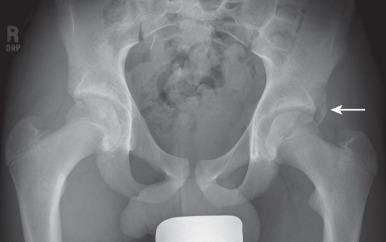
Apophyseal and ligamentous avulsion injuries are more frequent in the lower extremity than in the upper extremity. In particular in the lower extremity, the pelvis and knee are the most common sites for apophyseal avulsion injuries.
After the apophysis, the next weakest component of the musculoskeletal unit is the myotendinous junction, which is therefore the most common site of muscular injury. Myotendinous tears are an acute event during a physical activity in which a child can pinpoint the time (within seconds) in which the injury occurred. This should be differentiated clinically from delayed onset muscle soreness (DOMS), which is not related to a single event but rather an activity with repetitive eccentric and concentric muscle contractions with no acute pain at the time of the activity. Instead, symptoms and pain usually are felt in the days after the activity.
In the acute setting, the displaced avulsion fracture fragment is present without proliferative callus formation (see Fig. 144.1 ). During healing, proliferative callus will form, suggesting its subacute or chronic nature.
When radiographs are negative and no displaced fragment exists, an MRI scan may be obtained. MRI may demonstrate subtle edema of the apophysis and metaphyseal equivalent bone, physeal equivalent edema and widening, and adjacent soft tissue edema ( e-Fig. 144.2 ). The term fracture should be used only when a linear displaced or nondisplaced fracture is present. When edema alone is present within the apophysis and adjacent soft tissues, the term avulsion injury can be used.
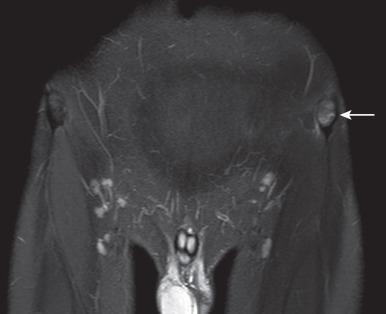
MRI may also demonstrate avulsion injuries and fractures at the level of the chondro-osseous junction ( Fig. 144.3 ).
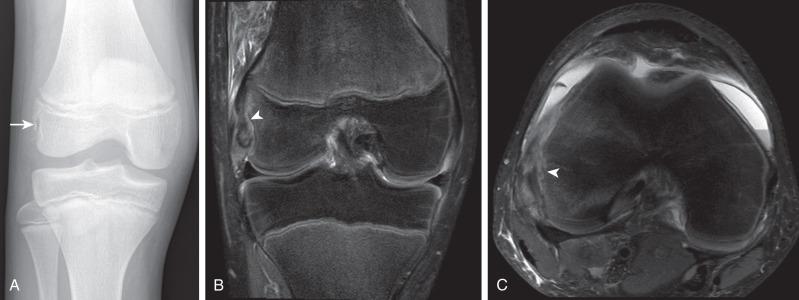
MRI is preferred for delineating the remainder of the musculoskeletal unit. When muscle edema is present related to trauma, three possible etiologies exist: (1) DOMS ( Fig. 144.4 ), (2) direct muscle contusion ( e-Fig. 144.5 ), and (3) myotendinous muscle tear ( Fig. 144.6 ). With DOMS, MRI shows diffuse edema on fluid sensitive sequences without discrete fiber disruption. Direct muscle contusions show similar changes to DOMS but are more focal in nature when the injury is mild, with discrete fiber disruption and hematoma formation when the injury is more severe. In the setting of muscle hematomas, these may mimic an intramuscular abscess. Gadolinium-enhanced, T1-weighted, fat-saturated magnetic resonance (MR) imaging may demonstrate rim enhancement for both hematomas and intramuscular abscess. T1-weighted imaging without gadolinium may demonstrate T1-weighted hyperintense foci related to blood products and may suggest muscle hematoma and, less likely, intramuscular abscess with proteinaceous content. Evidence of myotendinous muscle injury can range from edema to complete disruption with muscle fiber and aponeurosis retraction.
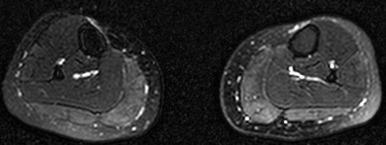
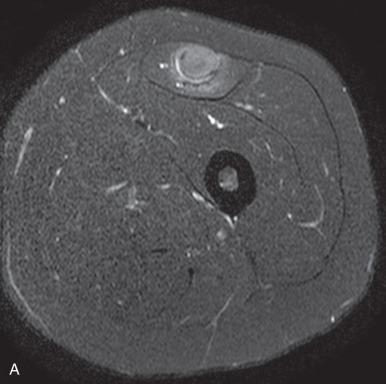
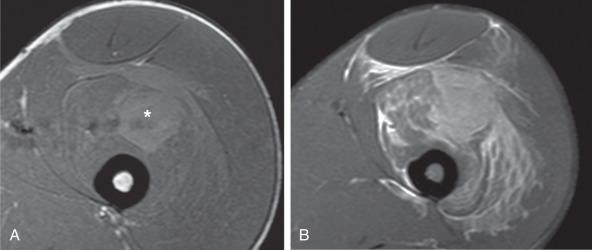
Treatment varies, depending on the location of the apophyseal avulsion injury. In the pelvis, the majority of apophyseal avulsion injuries are treated conservatively with rest. Surgical reduction and fixation may be necessary when the avulsed fracture fragment is greater than 2 cm. During the healing phase, radiographs may be helpful to monitor callus formation and alignment. Apophyseal avulsion fractures elsewhere are usually treated conservatively, and surgical reduction is based on degree of apophyseal displacement. For instance, medial epicondylar avulsion fractures are typically treated surgically when the displaced fragment is greater than 5 mm.
Myotendinous tears are treated conservatively with 2 to 3 weeks of rest before returning to sport activities. DOMS is also treated conservatively, and symptoms usually resolve within a week.
The anterior compartment of the knee is composed of the quadriceps tendon, patellar bone, patellar tendon, and tibial tuberosity. The patella is a sesamoid equivalent for the quadriceps mechanism. Acute forceful concentric or eccentric contraction of the quadriceps muscle may lead to acute avulsion injuries of the inferior patellar pole (chondro-osseous avulsion injury, patellar sleeve fractures) and tibial tuberosity (apophyseal avulsion injury); whereas repetitive motion is the culprit for tendinopathy and chronic avulsive injuries affecting the inferior patellar pole in Sinding-Larsen-Johansson disease and the tibial tuberosity in Osgood-Schlatter disease . When pathology is isolated to only the proximal patellar tendon, it is called jumper's knee and tends to occur in patients who are skeletally mature. Sinding-Larsen-Johansson and Osgood-Schlatter diseases usually occur during adolescence and often affect both knees. Both bone and tendon injuries often coexist in the same knee.
Although imaging is helpful for the diagnosis of Sinding-Larsen-Johansson and Osgood-Schlatter diseases, the diagnosis for these chronic conditions is made clinically with radiographic confirmation of findings, not by imaging alone. Advanced imaging confirms the diagnosis and excludes alternative etiologies. MRI should not be performed routinely on these patients if radiography and clinical diagnosis confirm the disease.
Patellar sleeve fractures represent an acute avulsion fracture of the inferior pole of the patella. This occurs at the chondro-osseous junction of the patella tendon origin. On radiography and MRI, a small linear or curvilinear fragment of bone may be identified ( Fig. 144.7 ). On MRI, edema within the patella, the superior aspect of Hoffa's fat pad and in the peripatellar soft tissues are present in the acute setting. This should be differentiated from chronic repetitive avulsive injuries to the inferior patellar pole occurring in Sinding-Larsen-Johansson disease in which the inferior patellar bone has had time to remodel. Therefore on radiography and MRI, well-corticated variable size ossicles are typically seen ( Fig. 144.8 ) with adjacent soft tissue swelling and edema. As previously noted, this is typically a clinical diagnosis and, if well-corticated ossific fragments are present without adjacent edema, this finding may be related to an accessory ossicle(s).
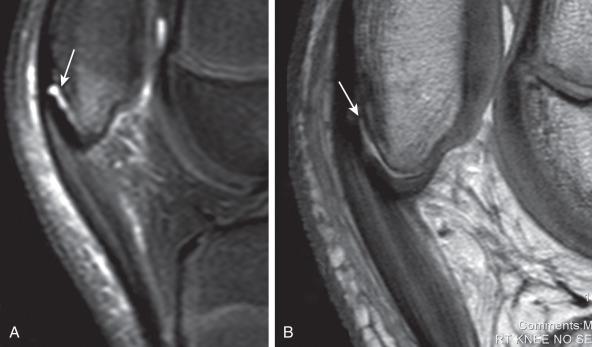
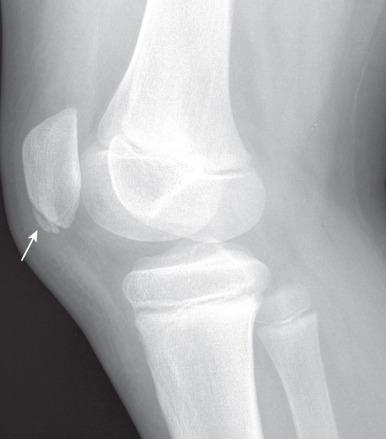
Acute tibial tuberosity avulsion fractures result from forceful contraction of the patella tendon leading to a tibial tuberosity–sided linear or curvilinear avulsion fracture fragment at the level of the chondro-osseous junction ( Fig. 144.9 ) or to uplifting of the entirety of the tibial tuberosity, with resultant Salter-Harris-type injury with physeal equivalent widening ( Fig. 144.10 ). On MRI, edema is seen within the tibial tuberosity, and this may extend posteriorly to involve the remainder of the tibial epiphysis. Inferior Hoffa's fat pad and pretibial edema are often present. These changes should be differentiated from chronic repetitive avulsive injury affecting the tibial tuberosity and leading to Osgood-Schlatter disease. With Osgood-Schlatter disease, rather than linear avulsion fracture fragments, the tibial tuberosity and tibial tuberosity avulsion fragments have had time to remodel. Therefore on radiography and MRI, well-formed, variable-size, well-corticated ossicles may be seen ( e-Fig. 144.11 ). On MRI, edema within the avulsed separate ossicles and tibial tuberosity are present and are related to the acute on chronic nature of the injury. In addition, edema within Hoffa's fat pad and pretibial edema are often present as well.
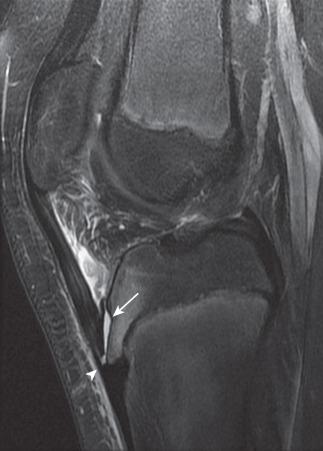
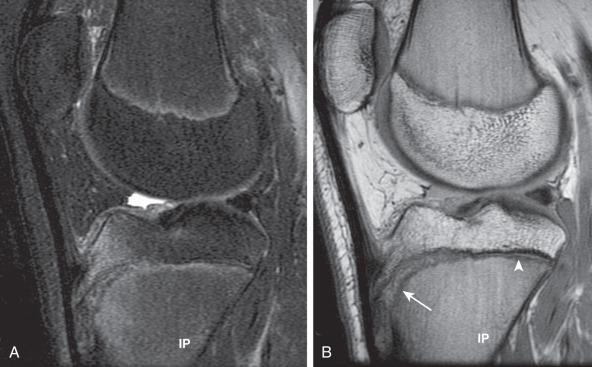
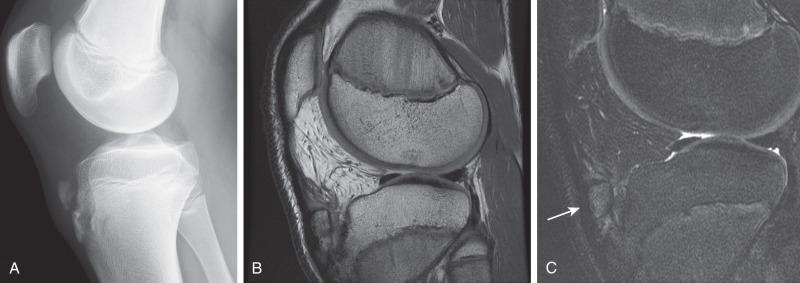
Patella tendinopathy and patellar tears ( e-Figs. 144.12 and 144.13 ) may be evaluated by ultrasonography or MRI. Thickening of the tendon with longitudinally or transversely oriented tears may be seen as well as edema within the prepatellar soft tissues and Hoffa's fat pad. Marked tendinous hyperemia on color sonography denotes neovascularity and has been associated with a higher degree of pain. MRI diagnosis of jumper's knee should ideally be made on longer echo time sequences to avoid “magic angle artifact.”
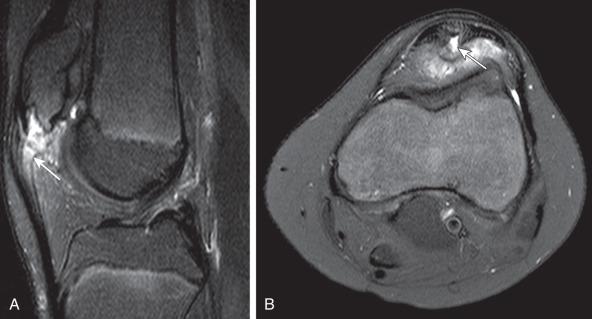
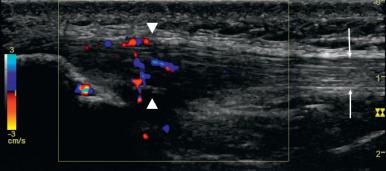
Sinding-Larsen-Johansson disease, Osgood-Schlatter disease, and jumper's knee are all treated conservatively with rest. When displaced, acute avulsion fractures of the inferior patellar pole or tibial tuberosity may be treated by open reduction with patellar tendon reconstruction, particularly if patella alta is also present. For avulsion fractures, care should be made to determine if the fracture is complete, incomplete, displaced, or nondisplaced. If the avulsion fracture is incomplete (see Fig. 144.9 ), affected children may benefit from conservative nonsurgical treatment.
The patella is a sesamoid bone in the extensor mechanism that lies within the concave-shaped femoral trochlear fossa. It has two primary facets: medial and lateral. The lateral facet is usually the dominant and larger facet, and articulates with the lateral aspect of the trochlear fossa. With knee flexion, the patella will concentrically locate within the trochlear fossa. With knee extension, the patella preferentially subluxes laterally in patients with or without underlying patellofemoral dysplasia because the lateral patellofemoral articulation is shallow compared with the medial articulation, and the vastus lateralis activates when the knee is extended.
Multiple variables may predispose a patient to patellar dislocation. This includes a large Q-angle, muscle imbalance with dominant vastus lateralis musculature, patella alta, rotational abnormalities of the tibia and femur, and overall ligamentous laxity. Larger Q-angles direct the quadriceps muscle vector force on the patella laterally. Because the patellar bone captures within the trochlear groove with knee flexion, in the setting of patella alta, it takes relatively more knee flexion for the patellar bone to capture. Both excessive external tibial torsion and increased femoral anteversion can predispose a child to patellar dislocation. The normal degree of external tibial torsion is approximately 28 degrees at age 4 years and increases to approximately 38 degrees at skeletal maturity. The normal degree of femoral anteversion is approximately 40 degrees at birth and approximately 15 degrees at skeletal maturity.
The earlier age at the first time patellar dislocation occurs, the higher the incidence of recurrent patellar dislocation and the higher the propensity to develop more severe secondary patellofemoral dysplasia. This may be related to laxity of the injured medial retinaculum and remodeling at the level of the patellofemoral joint after initial injury. Secondary patellofemoral dysplasia results from poor articulation at the level of the patellofemoral joint and can be exacerbated by muscle imbalance and traumatic patellar dislocation. Therefore patients with secondary patellofemoral dysplasia may have had a normally appearing patellofemoral joint at birth, but over time, the joint becomes dysplastic. Patellofemoral dysplasia can also occur as a primary congenital anomaly.
Radiographs can identify risk factors for patellar dislocations, such as patella alta and patellofemoral dysplasia, as well as injuries related to a dislocation/relocation event, such as joint effusions, osteochondral fractures, and osseous avulsions. An axial view of the patella (i.e., merchant or sunrise view) is helpful to evaluate for avulsion fractures, which occur along the medial pole and are a result of avulsion injury at the insertion of the medial patellofemoral ligament in both the acute setting ( Fig. 144.14 ) and for old injuries ( e-Fig. 144.15 ). Acute patellar avulsion fractures are sliver-like, whereas old injuries are round and corticated.
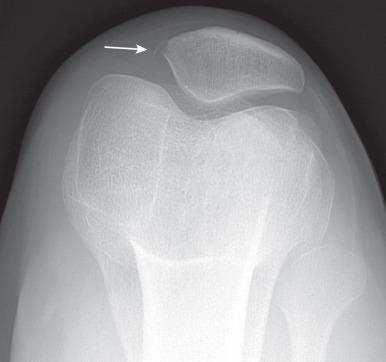
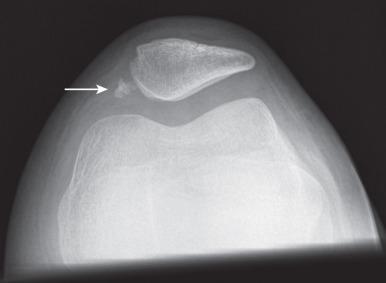
The axial view should also be assessed for osteoarthritic changes of the patellofemoral joint, lateral patellar tilt, and patellar subluxation/dislocation. With regard to patellar location, the axial view may be misleading if not obtained with the knee in 30 degrees flexion. Knee flexion facilitates patella reduction, whereas knee extension may exaggerate patellar tilt and lateral patellar subluxation. When the knee axial view is obtained with less knee flexion, the trochlear fossa may appear shallow and should not be mistaken for patellofemoral dysplasia. Because of positioning variability, a true lateral view of the knee is a great resource that displays the entire trochlear floor and can support a diagnosis of trochlear dysplasia. A positive crossing sign indicates that the lateral side of the trochlea is flat or in plane with the lateral condyle. This can be correlated with a properly flexed axial view to confirm a flat or even convex-appearing trochlear fossa. On the axial view, a lateral dominant patellar facet can be a feature suggestive of patellofemoral dysplasia. With progressive patellofemoral dysplasia, the trochlear fossa becomes more convex in appearance, and the patellar bone loses its normal angular appearance.
Computed tomography (CT) may be obtained in the workup of patellofemoral dysplasia to evaluate for rotational abnormalities (namely excessive external tibial torsion and femoral anteversion) and for a dynamic evaluation ( e-Fig. 144.16 ). Three separate CT acquisitions are obtained at different degrees of knee flexion (e.g., 45, 30, and 15 degrees). If the patella dislocates at 15 degrees but is located at 45 and 30 degrees, it is considered a mild degree of patellar dislocation. However, if the patella dislocates at 30 or 45 degrees of knee flexion, it is a more severe degree of patellar dislocation. CT for patellar dislocation can also be used to evaluate the degree of patellofemoral dysplasia and secondary patellofemoral osteoarthritis, with changes similar to what may be seen on axial-view radiographs. The degree of lateralization of the tibial tuberosity should also be determined. This represents the distance between the midpoint of the tibial tuberosity and the deepest component of the trochlear groove on axial slices, the tibial tuberosity-trochlear groove (TT-TG) distance. If the tibial tuberosity is greater than 2 cm lateral with respect to the trochlear groove, a higher incidence of patellar instability exists ( e-Fig. 144.17 ).
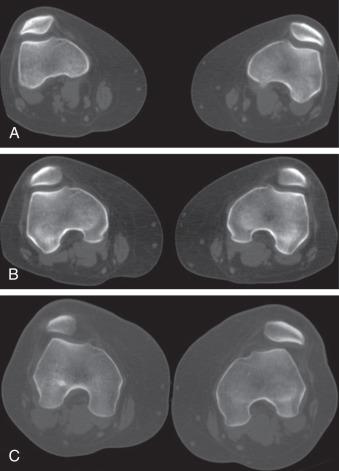
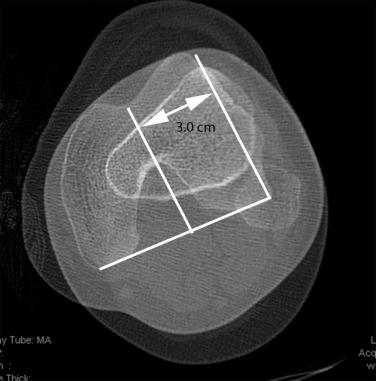
MRI complements radiography and CT findings and can also evaluate rotational abnormalities. Sometimes, children are referred for knee pain, and the diagnosis of patellar dislocation and patellofemoral dysplasia may be first suspected on MRI. On MRI for acute patellar dislocation, characteristic bone contusions may be seen along the medial patellar pole and anterolateral femoral condyle ( Fig. 144.18 ). The bone contusions occur from compressive forces during relocation of the patella after the dislocation. Other findings that may be seen include patellar avulsion fractures, medial retinacular and patellofemoral ligament tears, cartilage injuries, and intraarticular bodies. Patellofemoral dysplasia ( Fig. 144.19 ) and secondary degenerative changes should also be assessed by MRI.
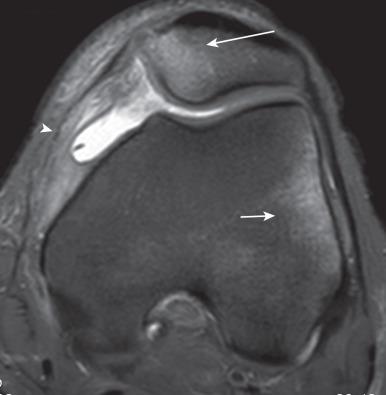
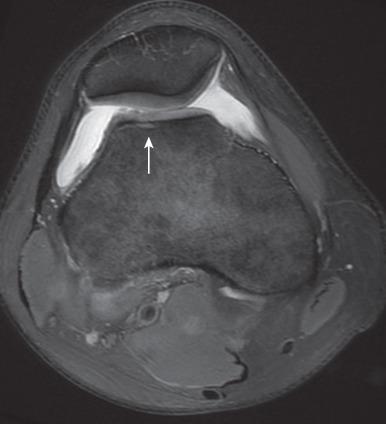
Treatment for patellar dislocation should be approached from two perspectives: (1) treat biomechanical instability, which can be addressed by physical therapy and operative repair, and (2) treat mechanical symptoms related to sequelae from acute dislocation usually from intraarticular bodies or chondral injuries.
Patients with first-time patellar dislocation and those with recurrent patellar dislocation may be treated conservatively with physical therapy and bracing. The goal of treatment is to improve gluteal and vastus medialis muscle activity, which facilitates medial location of the patella. Should physical therapy not improve symptoms, surgical repair is considered, although no single effective surgical technique has been advocated in the literature. Surgical approaches include lateral retinacular release, patellofemoral ligament repair and reconstruction, trochleoplasty (to deepen the sulcus), and tibial tubercle transfers (medialization of the tibial tubercle), as well as rotational osteotomies to treat excessive tibial torsion and femoral version. The surgical goal is to facilitate patellar bone capture by the trochlear fossa and medialization of patellar biomechanical vector forces.
When intraarticular bodies or cartilage injury is identified and the child has mechanical symptoms such as locking, arthroscopy may be performed to remove the bodies and perform cartilage debridement or more advanced cartilage restoration techniques.
Become a Clinical Tree membership for Full access and enjoy Unlimited articles
If you are a member. Log in here